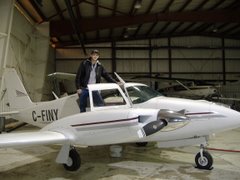I've been asked by a couple of my non-pilot readers a few weeks back now to post some explanations of some of the aviation abbreviations and terms that I use often. So I went back through some of my posts and picked out all my commonly used terms that I don't usually provide explanations for directly in the posts, so here they are:
AWOS - Automated Weather Observing System. This is a radio broadcast that repeats every couple minutes with the current weather report for that particular airport. The pilot usually tunes it in to listen to prior to takeoff and while he's approaching the airport to land. The report includes all the weather items included in a METAR (see below)
GFA - Graphic Forecast Area. This is a regional weather chart that depicts current and forecast weather (up to 12 hrs ahead) in a picture format. It displays weather systems moving through the area and describes the resulting weather.
METAR - I have no idea what the letters stand for, I think its a french derivative. This is the hourly weather observations that are given at certain airports equipped with weather stations. It reports winds, visibility, type and intensity of precipitation, cloud layers, temperature, dewpoint, and altimeter setting (atmopsheric pressure).
PAPI/APAPI - Precision Approach Path Indicator/Abbreviated PAPI. These are at set of 4 lights (or two lights in the case of APAPI) that some runways have set up beside a runway which can indicate to an aircraft on approach whether he is on the correct glideslope or not. If 2 of the 4 lights are white and 2 are red, the approach path is on the correct angle, if they're are more red than white - too low. More white than red - too high.
PIC - Pilot in Command. Self Explanatory.
PIREP - Pilot Report. This just what it sounds like, but is usually in regards to weather conditions. Pilots can report weather conditions (to flight service) they experience during their flight. This PIREP is then logged in the system and can be used to advise other pilots of the conditions.
Radio Service - Sort of like Air Traffic Control with the difference that ATC issues instructions and clearances to the pilot, whereas a Radio Service is advisory in nature. A pilot will report his/her intentions, and the Radio Service will then relay that information to other pilots as well as any other information that might be useful to the pilots.
STOL - Short Takeoff and Landing. Generally in reference to aircraft specifically designed for operating out of short runways, or kits that can be installed on aircraft to improve the landing and take-off distances.
TAF - Terminal Aerodrome Forecast. Similiar in format to a METAR giving the same information, except that a TAF gives forecasted weather (up to 6 hrs in advance), not observed weather.
Subscribe to:
Post Comments (Atom)




Thanks for the terms,Chad. Now we have a guide to match them.
ReplyDeleteIf you take off in below freezing temp, do you still get icing?
All very interesting.
This comment has been removed by a blog administrator.
ReplyDelete